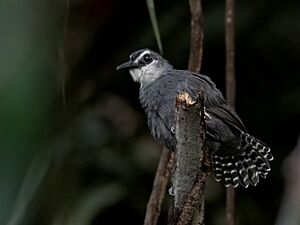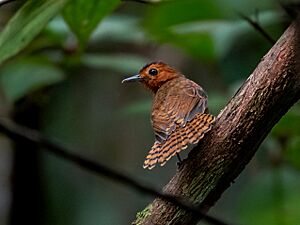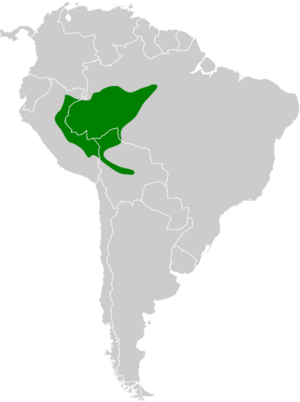White-throated antbird facts for kids
Quick facts for kids Deep-throated antbird |
|
|---|---|
 |
|
| A male at Careiro, Amazonas, Brazil | |
 |
|
| A female at the same locality | |
| Conservation status | |
| Scientific classification | |
| Genus: |
Oneillornis
|
| Species: |
salvini
|
 |
|
| Synonyms | |
|
Gymnopithys salvini |
|
The white-throated antbird (Oneillornis salvini) is a small bird that lives in the forests of South America. It belongs to a group of birds called "typical antbirds." You can find this bird in parts of Bolivia, Brazil, and Peru.
Contents
About the White-throated Antbird
How Scientists Name Birds
Scientists give every animal a special two-part name, like Oneillornis salvini for this bird. A German bird expert named Hans von Berlepsch first described this antbird in 1901. Over time, scientists learned more about birds by studying their DNA. This led them to move the white-throated antbird into a new group, or genus, called Oneillornis. This bird is the only one of its exact kind, meaning it's monotypic.
What Does It Look Like?
The white-throated antbird is about 13 to 14.5 centimeters (5 to 5.7 inches) long. It weighs between 22 and 28 grams (0.78 to 0.99 ounces).
- Males: Adult males are mostly gray. They have a white stripe above their eye and a white chin and throat. Their wings are a darker gray, and their tail has blackish-gray and white stripes.
- Females: Adult females look quite different! The top of their head is dark olive-brown. Their neck, sides of the head, throat, and upper chest are a reddish-brown color. Their back is olive-brown with black and reddish-brown stripes. Their tail is reddish-brown with thin black stripes. Their lower chest and belly are reddish-yellow-brown. Females living in the northern parts of their range tend to be darker.
- Young Males: Younger males are dark gray with brown wings. Their throat might have patches of white.
Where Does It Live?
The white-throated antbird lives in the western part of the Amazon Basin. You can find it in eastern Peru, southwestern Brazil, and northwestern and central Bolivia. This bird mostly lives in humid, wet evergreen forests. It prefers areas where the ground is firm and not usually flooded. It also lives in forests that flood sometimes. This bird almost always stays close to the ground, in the forest's lower plants. It usually lives below 450 meters (1,476 feet) in Brazil. In Peru, it can be found up to 800 meters (2,625 feet) high.
Behavior and Life Cycle
Movement and Travel
The white-throated antbird does not travel long distances. It stays in the same area its whole life.
How It Finds Food
This bird is a special kind of hunter called an "obligate ant follower." This means it always follows swarms of army ants, like Eciton burchelli and Labidus ants. As the army ants march through the forest, they scare out many small insects and spiders. The white-throated antbird then catches these creatures.
It usually hunts alone, in pairs, or in small family groups. It perches about 1 meter (3 feet) above the ground, sometimes as high as 3 meters (10 feet). When it sees prey, it quickly flies down to catch it. This bird is stronger than smaller antbirds but gives way to larger birds like woodcreepers.
Reproduction
Scientists don't know all the details about the white-throated antbird's nesting season. They know it nests in November in Peru and in March in Brazil.
Two nests that were found were made of dried palm leaves. One nest was shaped like a cup and placed in a hollow part of a palm tree stump. The other nest was flatter and found in a small group of Heliconia plants. Both nests had two eggs. The eggs were light pink with maroon speckles. We don't yet know how long the eggs take to hatch or how long it takes for the young birds to leave the nest. We also don't know much about how the parents care for their chicks.
Bird Calls and Songs
The white-throated antbird has a unique song. One expert described it as a "slow, strong series of 3-4 notes that go down in pitch." Another described it as "RHEEE?-rheee?-rheee?-rheee?-rhrrrr." Its calls include a "puttering, descending rattle" and a clear "tchup."
Conservation Status
The IUCN (International Union for Conservation of Nature) has listed the white-throated antbird as a species of "Least Concern." This means it is not currently in danger of disappearing. It lives across a large area, but its population size is unknown. Scientists believe its numbers are slowly going down.
No major threats have been found for this bird right now. It is quite common in many parts of its home range. It lives in several protected areas. Also, large parts of its habitat in Brazil are still untouched by humans. However, this bird is thought to be very sensitive to human activity and changes in its environment.


